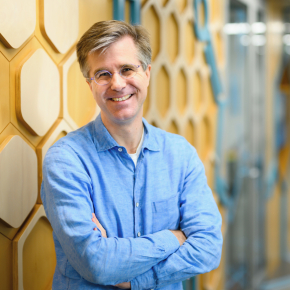The CNRS Institute of Chemistry welcomes Christopher Barner-Kowollik as the Ambassador in Chemical Sciences
On April 28, Christopher Barner-Kowollik, distinguished Professor of Chemistry at the Queensland University of Technology (QUT), will start a series of lectures in several French CNRS laboratories as the Ambassador in Chemical Sciences in France. Professor Barner-Kowollik’s research focusses on macromolecular photochemistry and particularly how light can be finely gated to generate advanced soft matter materials, including via light-driven 3D printing methodologies. He tells us all about “lighting the way to new synthetic materials.”
Fusing polymer chemistry and photochemistry has opened a new route for the manufacturing of soft matter objects; can you explain how you became a pioneer in this field?
I have always been fascinated by light and its interactions with matter. Without light, there would simply be no life on Earth, as it enables the key biochemical process that sustains us all – photosynthesis. However, in human hands, triggering chemical reactions with light was mostly based on very broadly emitting light sources that emit many colours of light (i.e., wavelengths) at the same time. This made the triggering process very undefined, very much like hitting an object with a sledge hammer to shape it, instead of using a refined precision tool. Over the years, laser systems became more and more sophisticated, producing light output at almost any preselected wavelength via the push of a button.
My team and I saw a key opportunity to transform photochemistry by a precision approach, using defined monochromatic wavelengths to induce chemical transformations, similar to shaping an object with a precision tool. By interrogating photochemical reactions in a wavelength-by-wavelength gated fashion, we first found that the colour of a chemical, defined by its absorption spectrum, is no guide to its actual chemical reactivity. A chemist can thus not rely on the absorption spectrum to conduct precise reactions. We termed our wavelength-by-wavelength probing of photochemical reactions ‘action plot analysis’. To date, many reactions have been analysed by action plots, including in other laboratories, allowing for the first time to apprehend photochemical processes with unprecedented precision.
This precision allows to design reaction systems, including in polymer chemistry, that respond selectively to specific wavelengths. For example, it is now possible to generate different material properties from a specific 3D printing resin, simply by changing the colour of light it is irradiated with and provided it contains two independent (i.e. orthogonal) photochemical reaction systems. The possibilities of precision photochemistry underpinned by action plot analysis are endless, enabling processes where different reactions occur independently of each other, or require two colours of light at the same time to occur (i.e. synergistically) or even where one colour of light starts a chemical reaction and another ceases it (i.e. antagonistically).
What future outcomes can we expect in the next 5 to 10 years?
I hope that our action plot analysis technique will be used by photochemists all over the world, as the tuneable laser systems that underpin it have become very economical and simple to operate. We have provided an overview and tutorial here. We hope that we will soon fully establish multi-colour 3D laser lithography to allow 3D printing of disparate material properties from one resist cartridge - perhaps the most critical challenge in 3D printing - as well as enable other key advances in light driven 3D printing, such as sub-diffraction printing. In theory, it should be possible to print single polymers chains, although this is currently science fiction. Yet action plot analysis enables precision synthesis in a way that thermally driven reactions never will. With precision photochemistry, one can manipulate one part of a molecule, while leaving another part completely untouched, in an approach one could call ‘photochemical molecular surgery’.
As a CNRS ambassador of Chemical Sciences, what are you most looking forward to during your French conference tour?
I look very much forward to interacting with the French chemistry community, including at the AMPE conference in Paris starting on the 23rd of April. Over the last decades, I have had the privilege to work with many French scientists as well as welcome French post-doctoral researchers in my laboratories in Australia and Germany. French chemistry is absolutely word class and I look forward to learning a lot during my lecture tour. I also hope that I can showcase Australian chemistry and encourage scientific exchanges between our two countries. In an increasingly fractured geopolitical landscape, it is critical to reinforce the message that science knows no borders nor nationalities. We are one community that is solely dedicated to scientific fact finding, understanding the world around us and bettering the living conditions on our planet. On a personal level, I look forward to meeting old friends again and making new ones in the universities and cities that we will visit.
Lectures Program :
- 28/04/2023 - Paris - Jutta Rieger - Institut parisien de chimie moléculaire (IPCM)
- 02/05/2023 - Bordeaux – Sébastien Lecommendoux - Laboratoire de chimie des polymères organiques (LCPO)
- 03/05/2023 - Marseille – Didier Gigmes - Institut de chimie radicalaire (ICR)
- 05/05/2023 - Lyon – Jannick Duchet-Rumeau - Laboratoire Ingénierie des matériaux polymers (IMP)
